 W
WThe mole salamanders are a group of advanced salamanders endemic to North America. The group has become famous due to the presence of the axolotl, widely used in research due to its paedomorphosis, and the tiger salamander which is the official amphibian of many states, and often sold as a pet.
 W
WThe mole salamanders are a group of advanced salamanders endemic to North America. The group has become famous due to the presence of the axolotl, widely used in research due to its paedomorphosis, and the tiger salamander which is the official amphibian of many states, and often sold as a pet.
 W
WThe California tiger salamander is a vulnerable amphibian native to California. It is a mole salamander. Previously considered to be a subspecies of the tiger salamander, the California tiger salamander was recently designated a separate species again. The California tiger salamander distinct population segment (DPS) in Sonoma County and the Santa Barbara County DPS are listed as federally endangered, while the Central California DPS is listed as federally threatened. The Sonoma County, south San Joaquin, and the Santa Barbara County DPS have diverged from the rest of the California tiger salamander populations for over one million years, since the Pleistocene and they may warrant status as separate species.
 W
WThe axolotl, Ambystoma mexicanum, also known as the Mexican walking fish, is a neotenic salamander related to the tiger salamander. Although colloquially known as a "walking fish", the axolotl is not a fish but an amphibian. The species was originally found in several lakes, such as Lake Xochimilco underlying Mexico City. Axolotls are unusual among amphibians in that they reach adulthood without undergoing metamorphosis. Instead of developing lungs and taking to the land, adults remain aquatic and gilled.
 W
WAmbystoma talpoideum, the mole salamander, is a species of salamander found in much of the eastern and central United States, from Florida to Texas, north to Illinois, east to Kentucky, with isolated populations in Virginia and Indiana. Older sources often refer to this species as the tadpole salamander because some individuals remain in a neotenic state. This salamander lives among the leaf litter on the forest floor, migrating to ponds to breed.
 W
WAnderson's salamander is a neotenic salamander from Zacapu Lagoon in the Mexican state of Michoacán.
 W
WThe axolotl, Ambystoma mexicanum, also known as the Mexican walking fish, is a neotenic salamander related to the tiger salamander. Although colloquially known as a "walking fish", the axolotl is not a fish but an amphibian. The species was originally found in several lakes, such as Lake Xochimilco underlying Mexico City. Axolotls are unusual among amphibians in that they reach adulthood without undergoing metamorphosis. Instead of developing lungs and taking to the land, adults remain aquatic and gilled.
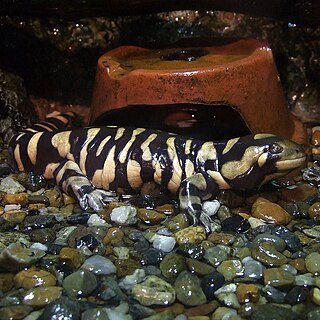 W
WThe barred tiger salamander or western tiger salamander is a species of mole salamander found from southwestern Canada in British Columbia, Alberta, Saskatchewan, and Manitoba, south through the western United States to Texas and northern Mexico.
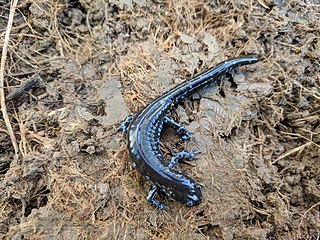 W
WThe blue-spotted salamander is a mole salamander native to the Great Lakes states and northeastern United States, and parts of Ontario and Quebec in Canada. Their range is known to extend to James Bay to the north, and southeastern Manitoba to the west.
 W
WThe California tiger salamander is a vulnerable amphibian native to California. It is a mole salamander. Previously considered to be a subspecies of the tiger salamander, the California tiger salamander was recently designated a separate species again. The California tiger salamander distinct population segment (DPS) in Sonoma County and the Santa Barbara County DPS are listed as federally endangered, while the Central California DPS is listed as federally threatened. The Sonoma County, south San Joaquin, and the Santa Barbara County DPS have diverged from the rest of the California tiger salamander populations for over one million years, since the Pleistocene and they may warrant status as separate species.
 W
WThe frosted flatwoods salamander is a small, elongated species of mole salamander. It has a small, indistinct head, short legs, and a long, rounded tail. Typical coloration consists of a background of brownish- to purplish-black overlaid with narrow gray or silvery-white reticulations, bands, or diffuse spotting. The gilled aquatic larvae are distinctly colored, having a series of bold brown and yellow longitudinal stripes.
 W
WThe Jefferson salamander is a mole salamander native to the northeastern United States, southern and central Ontario, and southwestern Quebec. It was named after Jefferson College in Pennsylvania.
 W
WThe Leora's stream salamander or ajolote is a rare species of mole salamander in the family Ambystomatidae. It is endemic to a very small area of land in the Iztaccihuatl-Popocatepetl National Park on the border of the State of Mexico with Puebla, with a single known population on Mount Tlaloc. Its very specific requirements as regards water quality militates against its survival in a habitat where water is being extracted, cattle graze and the salamander has traditionally been eaten as food. It has been listed as a threatened species by the Mexican Government and as "critically endangered" by the International Union for Conservation of Nature.
 W
WThe long-toed salamander is a mole salamander in the family Ambystomatidae. This species, typically 4.1–8.9 cm (1.6–3.5 in) long when mature, is characterized by its mottled black, brown, and yellow pigmentation, and its long outer fourth toe on the hind limbs. Analysis of fossil records, genetics, and biogeography suggest A. macrodactylum and A. laterale are descended from a common ancestor that gained access to the western Cordillera with the loss of the mid-continental seaway toward the Paleocene.
 W
WMabee's salamander is a species of mole salamander found in tupelo and cypress bottoms in pinewoods, open fields, and lowland deciduous forests, pine savannahs, low wet woods, and swamps. It usually burrows near breeding ponds. Eggs are attached to submerged plant material or bottom debris of acidic, fishless ponds in or near pine stands. In Virginia, it breeds in fish-free vernal pond in a large clear-cut area and in ephemeral sinkhole ponds up to 1.5 m deep, within bottomland hardwood forest mixed with pine. Larvae develop in the ponds. Distances moved into terrestrial habitat are unknown, but probably are greater than 150 metres (490 ft).
 W
WThe marbled salamander is a species of mole salamander found in the eastern United States.
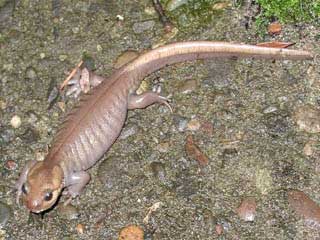 W
WThe northwestern salamander is a species of mole salamander that inhabits the northwest Pacific coast of North America. These fairly large salamanders grow to 8.7 in (220 mm) in length. It is found from southeastern Alaska on May Island, through Washington and Oregon south to the mouth of the Gulala River, Sonoma County, California. It occurs from sea level to the timberline, but not east of the Cascade Divide. Its range includes Vancouver Island in British Columbia and The San Juan Islands, Cypress, Whidbey, Bainbridge, and Vashon Islands in Washington.
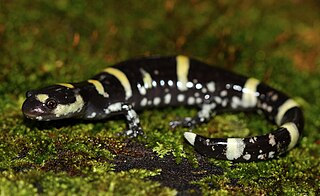 W
WThe ringed salamander is a species of mole salamander native to hardwood and mixed hardwood-pine forested areas in and around the Ozark Plateau and Ouachita Mountains of Arkansas, Oklahoma, and Missouri. Most specimens are found in the vicinity of Hot Springs, Arkansas, and the Missouri portion of the Ozark Plateau. Small populations have also been found in western Illinois and eastern Oklahoma.
 W
WThe Santa Cruz long-toed salamander is an endangered subspecies of the long-toed salamander, which is found only close to a few isolated ponds in Santa Cruz and Monterey Counties in California. It has a black body, broken yellow or orange irregular striping along its spine, and a tail fin well evolved for swimming. Like other mole salamanders, it is found near pools or slow-moving streams and has a very secretive lifestyle, making it difficult to find.
 W
WThe small-mouth salamander is a species of mole salamander found in the central United States, from the Great Lakes region in Michigan to Nebraska, south to Texas, and east to Tennessee, with a population in Canada, in Pelee, Ontario. It is sometimes referred to as the Texas salamander, porphyry salamander, or the narrow-mouthed salamander. The Kelley's Island salamander was synonymized with A. texanum in 1995.
 W
WThe spotted salamander or yellow-spotted salamander is a mole salamander common in eastern United States and Canada. The spotted salamander is the state amphibian of Ohio and South Carolina. This salamander ranges from Nova Scotia, to Lake Superior, to southern Georgia and Texas. Its embryos have been found to have symbiotic algae living inside them, the only known example of vertebrate cells hosting an endosymbiont microbe.
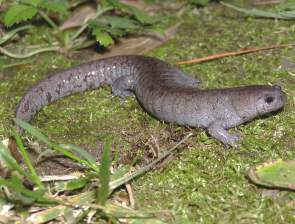 W
WThe streamside salamander is a species of mole salamander from North America, occurring in several Midwestern states of the USA.
 W
WThe Tarahumara salamander is a freshwater species of mole salamander in the family Ambystomatidae, endemic to Mexico. Its natural habitats are temperate forest, subtropical or tropical moist montane forest, subtropical or tropical high-altitude grassland, rivers, freshwater marshes, pastureland, and ponds.
 W
WTaylor's salamander, Ambystoma taylori, is a species of salamander found only in Laguna Alchichica, a high-altitude crater lake to the southwest of Perote, Puebla, Mexico. It was first described in 1982 but had been known to science prior to that. It is a neotenic salamander, breeding while still in the larval state and not undergoing metamorphosis. The lake in which it lives is becoming increasingly saline and less suitable for the salamander, which is declining in numbers. The International Union for Conservation of Nature (IUCN) has rated it as being "critically endangered".
 W
WThe tiger salamander is a species of mole salamander and one of the largest terrestrial salamanders in North America.
 W
WThe yellow-peppered salamander also known as the salamandra de Champala and the yellow-headed salamander, is a species of mole salamander native to areas at an elevation of 4900 ft around Santa Cruz, Rancho Malveste and Tapalpa in Jalisco, Mexico.